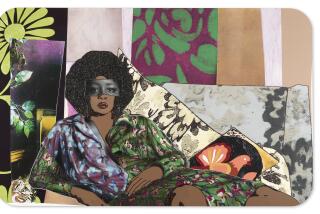The Prophet of Black Arts : VISIONS OF A LIBERATED FUTURE Black Arts Movement Writings <i> by Larry Neal edited by Michael Schwartz (Thunder’s Mouth Press: $19.95; 224 pp.)</i>
In his 1968 essay entitled “The Black Arts Movement,” poet Larry Neal wrote that “The motive behind the black aesthetic is the destruction of the white thing, the destruction of white ideas and white ways of looking at the world.”
Twenty-one years later, and eight years after his death at age 43, the black nationalist aesthetic Neal promoted has in a modified form moved from Harlem’s Black Arts Repertory Theater, which he co-founded in 1964 with Amiri Baraka, into our classrooms, onto the pages of our respected criticism, and echoes in virtually all our conversations about black art. It is a poetics that “proposes a separate symbolism, mythology, critique and iconology” for black people, one that privileges politics over art. But before I say another word, let me confess that while I now strongly disagree with Neal’s position, I was once one of many young artists influenced by his essays on culture and the historical events that produced them.
Michael Schwartz has collected the best (and most disturbing) of these pieces, along with Neal’s poetry, and insightful commentary on the man and his age by Baraka, Stanley Crouch, Charles Fuller and Jayne Cortez, in “Visions of a Liberated Future.” This is a book to be valued by anyone interested in the genesis of our current debate on how literature is affected by race and gender.
In 1965, Neal witnessed the assassination of Malcolm X in the Audubon Ballroom in Upper Manhattan. He vividly describes this event in “New Space/The Growth of Black Consciousness in the Sixties,” and the frustration felt by young blacks--James Brown’s “New Breed”--during that decade.
“All of the development of our remembered and unremembered history began to weigh down on us,” he wrote. “And the more of our memory that returned to us, the sharper, the more acute the pain became. The more we probed our history and the history of the Third World, the more angry we became, the more we nourished our hate for the white world. . . . White people deserved to be hated uncritically. . . .”
But Neal, recognizing the inadequacy of hate, saw how “We could never hope to develop a viable concept of self if that concept was purely based on hating crackers.” Therefore, black artists had to turn inward, using their love of blackness as a first principle for politically correct literature. In his essay “And Shine Swam On,” he wrote that “We will have to alter our concepts of what black art is, of what it is supposed to ‘do’. The dead forms taught most writers in the white man’s schools will have to be destroyed, or at best, radically altered. We can learn more about what poetry is by listening to the cadences in Malcolm’s speeches than from most Western poetics. . . . The poet must become a performer, the way James Brown is a performer--loud, gaudy and racy.”
Given these ideological definitions of art, Neal could not approve of many black works regarded by whites as masterpieces. “Our literature,” he said, “has succumbed to the role of merely providing entertainment for white people.” In nearly all these theoretical works, which proved essential for the shaping of a Black Aesthetic and cultural nationalism, he faults his predecessors for their lack of militancy: W. E. B. DuBois “was a somewhat stuffy intellectual with middle-class hang-ups”; the Harlem Renaissance “was, for the most part, a fantasy-era for most black writers and their white friends. For the community, it never existed”; James Baldwin “joined the tradition of pleading with white America for the humanity of the Negro instead of addressing himself to black people and their problems”; and he calls Ralph Ellison’s 1952 masterpiece, “ Invisible Man, “ “a profound piece of writing but the kind of novel that, nonetheless, has little bearing on the world as the ‘New Breed’ reads it. The things that concerned Ellison are interesting to read, but contemporary black youth feels another force in the world today.”
Clearly, these are superficial, badly confused evaluations of some of the finest authors in African-American literature. And Neal, as he matured, knew this. To his credit, he became increasingly troubled by his own extremism and wrote the equivalent of an apology in his well-known “Ellison’s Zoot Suit,” where he celebrates the masterful use of folk culture in “Invisible Man” and declares that black art “has finally got to exist as good art also because, in terms of the development of a national art, excellent art is, in and of itself, the best propaganda you can have.”
Throughout the 1970s and ‘80s, Neal found himself re-evaluating his earlier ideas in brilliant essays such as “My Lord He Calls Me by the Thunder,” which finds value in a black Christianity rejected by many other nationalists, and in his thoughtful examinations of Zora Neal Hurston’s fiction and the philosophy behind the blues.
However, his close friend, critic Stanley Crouch, concludes that Neal’s “turn” away from ideology was tragically incomplete, cut short by his death in 1981. Crouch understands better than this book’s other commentators how Neal’s honesty inevitably forced him to look beyond a limited, racial aesthetics based on rage. “Larry Neal is important,” Crouch writes in a fitting epitaph, “because he was one of the first who had been taken in by the self-separation of black nationalistic thinking to realize how little it had to offer and how easily it prepared the way for demagogues.”
An obvious commotion had started down in the front rows. Malcolm was standing at a podium. He stepped from behind the podium to quiet the commotion. He said something like, “Peace, be cool, brothers.” Then it came. The strongest possible message, direct. The shots came rapid fire. Malcolm fell back, his arms flung outward like wings from the impact of the bullets hitting him square in the chest. Then there was the rumbling of scuffling feet, and the chairs were overturned. After it happened there seemed to be a pause, then the fear was everywhere. People scrambled for cover on the floor under the tables in the back, shouting. Screams came from the women and children. It seemed like the shots were coming from all over the ballroom (a smoke bomb in the rear, found later, didn’t go off). Security guards were trying to reach Malcolm, trying to stop the assassins who now were safely escaping in the confusion. Ahada’s daughter bolted out of the seat beside us. Ahada managed to catch the child before she could be trampled by the mob. A gunman ran by us, shooting and hurdling over chairs in his way. He twisted and turned, and fired at a knot of black men chasing him. The man was still firing as he ran out of the door toward the 165th Street entrance. He was being chased by several of Malcolm’s men. They caught him at the top of the steps, and he was wounded in the thigh. Another assassin left by the side door, waving his gun, daring anyone to follow him. The whole room was a wailing woman. Men cried openly.
From “Visions of a Liberated Future.”
More to Read
The biggest entertainment stories
Get our big stories about Hollywood, film, television, music, arts, culture and more right in your inbox as soon as they publish.
You may occasionally receive promotional content from the Los Angeles Times.










